Episode 209
What you’ll learn in this episode:
- Why it’s harder to find quality vintage and modern costume jewelry today than in years past
- How Rosie secured a spot as an appraiser on Antiques Roadshow
- What Rosie looks for in the pieces she collects, wears and sells in her shop
- Where the term “costume jewelry” came from and its history
- Why Rosie is one of the only people in America who will repair costume jewelry
About Rosie Sayyah
Rosie Sayyah has been selling and repairing vintage and estate jewelry from her shop, Rhinestone Rosie, in Seattle since 1984. In the early 1980s, Rosie felt her family tradition of dealing in antiques calling to her. Upon leaving her corporate career in television, she decided to open a jewelry store that not only had unique, exciting items for sale, but also where she could restore greatness to jewelry that had fallen into disrepair. Teaching herself about vintage costume and estate jewelry culture and repair through books, hobby shops, and hands-on experience, Rosie has become a national expert in the field. In the late 1990s, she began appearing regularly on “Antiques Roadshow” on PBS TV and continues today as one of their expert appraisers.
Photos:
Three images of before, stone choices and final repair
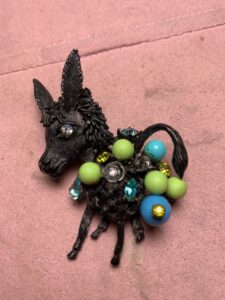
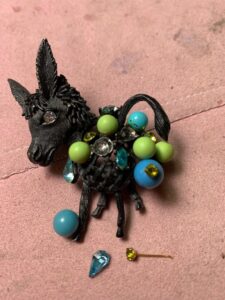
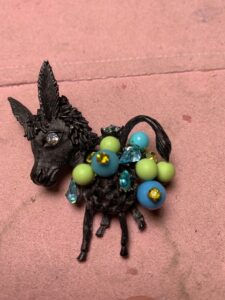
An acrylic purse handle becomes an avant- grade necklace by using one of these two chains.
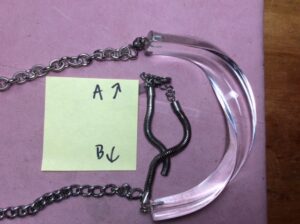
This pin needed a stone in the bottom. We gave the client two choices
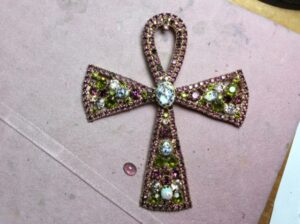
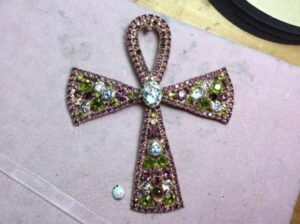
This jade necklace came in with knots in between that were too widely spaced.
We do all manner of restringing with a variety of materials.
This necklace was restrung with tightly knotted green silk thread
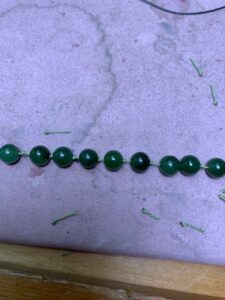
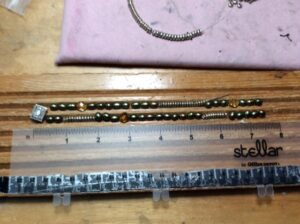
A Bakelite horse head receives a new bridle rein.
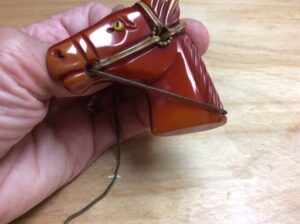
We have thousands of pieces for sale in the store also. Our inventory goes from 1870 to 1970 and newer!
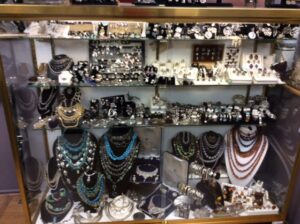
Most of our earrings for sale are either clip on or screwbacks, but we can change them to pierced for you. Or, bring in your own to have changed.
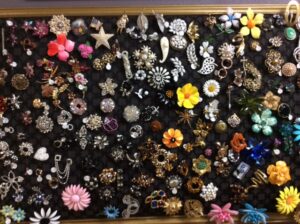
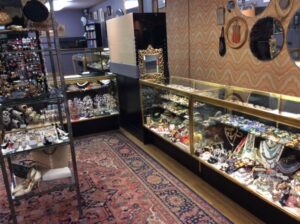
Restyling a bracelet by mixing two elements to create a new design
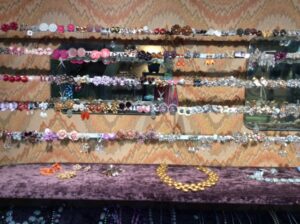
This is our Seattle location for 40 years, since 1984. We also have an online “store”
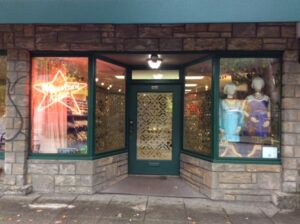
Additional resources:
Transcript:
Rosalie Sayyah, aka Rhinestone Rosie, first got jewelry lovers’ attention as an appraiser on Antiques Roadshow. But she has earned her customers’ loyalty for her ability to repair vintage costume jewelry and perfectly match missing rhinestones when no one else can. She joined the Jewelry Journey Podcast to talk about why so few jewelers will repair costume jewelry; what she looks for in the pieces she buys; and how to start a costume jewelry collection of your own. Read the episode transcript here.
made an impact nationwide during her 20 years as an appraiser on Antiques Roadshow. But
Sharon: Hello, everyone. Welcome to the Jewelry Journey Podcast. This is the first part of a two-part episode. Please make sure you subscribe so you can hear part two as soon as it’s released later this week.
Today, I’m talking with Rhinestone Rosie. You may already be familiar with Rosie. She has her own retail outlet in Seattle, and she does a strong mail order business. You may be familiar with her by seeing her on Antiques Roadshow giving the price of vintage jewelry to people who want to know.
All I know is that whenever I have a piece and I can’t find the stone that’s the right size, or I know it would be impossible to find the right kind, the color of the stone, or I know it’s out of production—maybe it’s a really old piece—I turn to her. She hasn’t let me down yet. Many of her stones are out of stock elsewhere, but somehow she manages to find them. We’ll hear all about her business today. Welcome to the program.
Rosie: Thanks for having me. It’s a pleasure. I love to talk about jewelry.
Sharon: I’m so glad you’re here. How did you choose the name Rhinestone Rosie?
Rosie: It was kind of a joke. I was an English minor in college, and alliteration is something that’s very memorable. I was dealing with my sister over the mail. She was sending me pieces and I would sell them. Just as a joke, I signed a check Rhinestone Rosie and it stuck.
Sharon: So, from the get-go, from day one, the name of your business was Rhinestone Rosie.
Rosie: That’s right. That’s correct.
Sharon: Does Rhinestone Rosie refer to any kind of costume jewelry stones or just rhinestones?
Rosie: Oh no, we deal with all kinds of jewelry. Beads and metals and pearls, all materials, and actually all ages. We do a lot of repairs. In our shop, our inventory goes from, I would say, the 1870s through present day.
Sharon: I know you have some pretty old vintage pieces, but I don’t know how old the antique line goes. A hundred years?
Rosie: Exactly.
Sharon: When did you first become attracted to rhinestones?
Rosie: It’s hard to say. My parents had a secondhand business, and they repaired things and sold them. This was in Orlando, Florida. I helped my mom reupholster furniture, and sometimes in the old furniture, we would find a piece of jewelry and she would give it to me. It wasn’t always rhinestones. I collected rocks when I was a kid, and they always had cut glass in the store. They had a secondhand store, and I just loved that cut glass. I’ve always liked shiny things, so that must have been what led me to this.
Sharon: And that includes all the shiny costume jewelry.
Rosie: Exactly, yes. And I like to work with my hands. I’ve been doing that since I was a little girl. So, working with things, that was just a natural offshoot.
Sharon: How did you get into the repair aspect of it? From your parents?
Rosie: No, actually after I had my baby, Lucia, I had a friend who had a vintage store in Seattle, and I would help her. I would bring home clothing and patterns and do mending on clothes, and she always had broken jewelry. I asked her one day, “Do you ever fix this?” She goes, “Oh, nobody really does. I do it once in a while.” So, I did some research and found out that nobody really repaired this jewelry. I thought, “Hmm, this is something I can do,” and I went to the local hobby shop, the guys that did model cars and model airplanes. They told me what lead solders to use, what glues to use, what paints to use. They were very helpful. They told me all kinds of stuff. I’m self-taught, so there it is. I bought a bunch of books and read the books. I learned how to knot in between beads and practiced through trial and error. I had to go through a lot of stuff.
Sharon: But you did this all yourself. As you were saying, there aren’t that many other places that do it.
Rosie: No, I don’t think there’s a full business anywhere that does it. A lot of dealers will do some of their own. A lot of my contemporaries who did similar things have all either passed on or decided to go a different route. I think I’ve got a monopoly on it.
Sharon: I don’t know anybody else who does it or has a store like yours, but I didn’t want to say it without knowing for sure.
Rosie: I think you’re right.
Sharon: That’s why I’m surprised you’re not in New York.
Rosie: Oh, no, we left Florida in 1973. We got as far across the country as we could. We wanted a big city, which Seattle is, and water and a temperate climate. We ended up settling here.
Sharon: It sounds like you made the right choice, but in terms of jewelry and being surrounded by jewelry, I think of New York first, Chicago maybe.
Rosie: I know. A lot of my contemporaries on the Road Show are from back East. I am an anomaly for sure, but it is what it is. That’s what I do and I do it well, if I might say.
Sharon: I know in my jewelry cabinet, I have a pile of things and say, “Oh, that should go to Rhinestone Rosie’s because I know she can fix it. There’s nobody else that does that.” Until I found you, there were pieces I would toss or, like you’re saying, give away or just say, “I can’t do anything with it.”
Rosie: Exactly, I remember. You did come into my shop. It was a pleasure to meet you in person one time. We did close for about three months during the pandemic. Now we’re only open three days a week in the brick-and-mortar store, although our online is still going on. I have people coming in almost daily with their pile of stuff that’s been saved for two or three years. They’re finally in the shop to get fixed.
Sharon: That’s interesting. I noticed that you’re only open a few days a week, which seemed to be fewer than before.
Rosie: Yes.
Sharon: What percentage of your business is mail order?
Rosie: I would say mail order and repair—because we do local repair. Of course, people walk in, and then people mail us things from all over the world. I think it’s about a 50/50 split, for online sales and for walk-in sales and repair.
Sharon: Wow! I have a friend who was a little hesitant about sending something that was precious to them. It wasn’t a precious item, but it was precious to them. I did it. I didn’t have any compunction. She did it, too. Where do you source the stuff you have, your vintage pieces? Where do you get them?
Rosie: People just bring it into the store. Sometimes, I’ll go to a yard sale or something and pick a piece, but mostly it’s people that are downsizing or someone just passed. The family has chosen the pieces they want. Sometimes there’s even a note in the collection, “Take this to Rhinestone Rosie.” It’s kept me going, and I don’t have to go out and beat the bushes.
Sharon: That’s great. Have you found it’s harder to get things in or harder to find things because costume jewelry—
Rosie: Oh yeah, the good stuff. I know there were a lot of manufacturers at the time, but I’d say the high-end pieces are in collectors’ hands, and they go from one collector to another collector. They’re not normally available in the market. Every once in a while, you will see that someone found something in a box of junk or something. What was so fun on the Road Show is uncovering something like that, but most of the time, it’s hard. It’s hard to find the good stuff, so you’ve got to change your focus. Right now, it’s more modernist and clean lines, big, chunky necklaces. It’s different than it was in, say, the 20s, 30s and 40s. Some people change.
Sharon: Do you think that costume jewelry has become more popular over the years or right now?
Rosie: People need to learn about the vintage pieces because there are lots of ones like dress clips or fur clips. They have a different way of attaching to the fabric, shall we say, but today a lot of stuff is coming out of China and Korea. There are very, very good contemporary artists making costume jewelry.
Sharon: With eBay and all the online sources, do you think it’s harder to find? People know what they have, let’s say.
Rosie: I don’t think they know what they have, but I think there’s a lot of the lower-end stuff. You could buy costume jewelry in a dime store. You could buy it in a pharmacy. You could buy it in a department store. You could buy it at a jewelry story. Jewelry stores and department stores usually sold the best quality. A lot of people bought the lower-end pieces because they were cheap, 10¢, 25¢, sometimes $1. I’ve seen more of that and less of the higher-end pieces.
Sharon: The audience can’t see this, but maybe you’ll send a picture. You have a beautiful Juliana necklace on. Do you think people know if they have a piece of jewelry on, I shouldn’t bring that to you, I should try and sell it elsewhere?
Rosie: It’s funny because they say, “I didn’t think you wanted that big, ugly stuff. It’s too gaudy,” and I’m like, “I want that. I want big, bold and ugly.” This is what people don’t understand, especially in the plastics. It’s very hard to find good Bakelite and celluloid and other plastics these days because people just toss them. But if they have something like the necklace I have on, I think it would give them pause, and they would bring something like that to me and I would be glad.
Sharon: As the market changes, like you mentioned, if it’s cleaner lines or contemporary, do you change with it?
Rosie: Oh sure. Part of my job, Sharon, is educating people on what they have, how to wear it, where it came from, when it was made, what the materials are. I’ll have someone come in. Let’s say they’re going to a wedding and they want a pair of earrings, and they think rhinestones can only be that clear, diamond-looking thing. When they walk in the shop, they realize it can be red, green, blue, purple with an iridescent coating like the necklace I have on, and they go out with a green pair of earrings instead of the clear ones. My job is not only educating people on what they have, but how to wear it, how to take care of it and, yes, it can be fixed. Don’t let your high-end jeweler tell you that it can’t be fixed. Just keep looking and you’ll find me.
Sharon: That’s really true. I have found that a lot of high-end jewelers tell me they can’t do anything, and somebody who’s more an engineering type feels they can do something with it. They can fix it.
Rosie: Exactly, yeah. I spend a lot of time re-repairing things that someone else did. “My father soldered it or my husband,” or “I used this kind of glue.” A lot of our repairs are removing the glue and old solder and getting it down to a basic where I can rebuild it back.
Sharon: Is it you or does somebody else work with you on repairs?
Rosie: Me and my daughter, we both do it in the shop. We don’t send it out. We don’t work with gold, and we don’t do silver solder. We do lead solder. But yeah, these hands, that’s what they do.
Sharon: Did you approach Antiques Roadshow or did they find you?
Rosie: It’s funny. In 1997, they did the first launch of the program, and Seattle was one of the test cities. Some of my mentors who do fine antique jewelry said, “Rosie, you should have been there. We had so much costume jewelry come in and we didn’t know what to tell people.” Long story short, my background is in television. I used to be a producer. I made commercials, and I knew the producer was the one to call.
So, I called WGBH, a guy named Peter, and I said, “Hey, my name is Rhinestone Rosie,” and there was a beat. I said, “I’m not a stripper. I can walk and talk at the same time. I’m fairly presentable on camera and I know about costume jewelry.” He said, “Yes, we would love to have you.” So, in 1998 in Portland, Oregon, it was my first show. I don’t think I taped. I was a little bit afraid. I’ve always been behind the camera, not in front of the camera, but I got over that pretty quick. Yeah, I did call him up and I said, “You need me.” I did it for 20 years.
Sharon: That’s sort of connected to this question. I didn’t know how to phrase it, but it seems to me that a lot of stylists would come in and say, “I’m doing a 40s show. What do I need?” Does that ever happen, that you have a stylist come in?
Rosie: It happened a lot more before the pandemic. Whether things changed in that industry, I don’t know, but yes, we had a lot of stylists or a magazine shoot. If they were doing a shoot, they would come in and pick out pieces. We used to rent our pieces, but we don’t do that anymore because people just wouldn’t return them. But yes, we get stylists. We would get theater seamstresses, the designers, the costume makers for theaters. We didn’t get a lot of movie people in, but maybe this’ll help. We can help them if they need us.
Sharon: Is it hard to decide what color or what kind of jewelry somebody should have?
Rosie: What I do is ask them about their lifestyle and what they want the piece for. I look at them. I see how they’re dressed, how their hair is cut, and I can pretty well sus out if they’re an edgy person or they’re a modest person, kind of timid. We have tiny, little earrings, big, bold, down-to-the-shoulder dusters, and you can usually tell by talking to someone. Someone who’s got nose piercings and whole-body tattoos, they’re not going to go for something real mild.
You can pick up on their body language. That’s helped me a lot, plus I encourage people to bring in outfits and put them on. It’s like the Barbie doll thing, just dress them and put jewelry on. They can try it on, and if the necklace is too short, we can adjust things. We can change earrings. Most of our earrings are clip-on or screw-back. We can change them to pierced if they want. We do that with our jewelry, or we can do it with your jewelry.
Sharon: What’s your return policy if they decide they want to take it home and try it?
Rosie: They get a store credit.
Sharon: A few of the pieces don’t work. Maybe it’s your daughter who told me that something wouldn’t work. I can’t even tell the stone apart from the original stones. How do you decide that? How do you decide if it’s going to work? Can you tell us about some of the pieces that haven’t worked, where you’ve had to come back to somebody and say, “I can’t find anything”?
Rosie: Some of the older stones, I would say pre-1910 to the late 1800s, a lot of those stones, I can’t find. I’ve taken stones out of pieces. I try very hard. If the piece comes in and the stone I’m matching is slightly discolored, I’m not going to put a brand new, shiny stone in its place. I will try to find in my pile of stones one that is slightly discolored. I try very hard to match it.
But, yeah, there are times when we just can’t fix a clasp or it’s in a place that’s too thick for us to solder or the thread is so weak and the restringing cost is prohibitive. We do understand sentimental value. We try to let people know that we appreciate what they have and we understand. It doesn’t matter to us if it cost 25¢. If it’s important to you, it’s important to us. So, if we honestly can’t fix it, we tell them, “No, we can’t fix it. We can’t help you.”
Sharon: How did you get your inventory? You have quite an inventory of stones that you can put in pieces.
Rosie: 40 years. I do have a source for new stones. Sometimes I’ll even go to Etsy and try to find something, but I’ve taken a lot of stones out of pieces. There have also been people through the years—like there was a lady who made earrings that sold in Nordstrom. Her name was Nellie, and she called me up and said, “I’m going out of business. Would you consider buying some of my stones?” That kind of thing. Jewelry stores have back inventory. When they close, I love to go in and dig around in their storerooms.
But I can’t buy stones that are unfoiled. I don’t do a lot of that because if you glue an unfoiled stone in, the foil is what makes a rhinestone shine. It’s like a little mirror. So, if it has no foil on it, I can’t really use it. A lot of stones out there have no foil backing, and I can’t use those. But most of time, it’s just here and there. People hear about me, or they have a hobby or they know somebody who’s fixed their own jewelry and they’re wanting to sell. I’ll look and see what they have, and I’ll pick and choose what I might use.
Sharon: Did you have any reservations about opening this kind of store in Seattle?
Rosie: No. I had it all over the kitchen table, and my husband said, “Hey, you’d better start a business because this has taken over our house.” I had no idea how to do it, but all I needed was the license. I shared space. Actually, right next door to where my shop is now, I was in the front of her store. I just had a desk and some jewelry behind me.
Now, this is a really good story. Again, my background is television, but I also have a degree in advertising and public relations. So, I printed up business cards and marched into I. Magnin and Frederick & Nelson and the major boutiques in downtown Seattle. I said, “This is what I do. I can help you,” and I walked out of every place with something to repair. That gave me street cred, so I could say, “I repair jewelry for I. Magnin or Nordstrom.”
I’ve never been afraid of talking about my abilities to do what we do and that we do it well, and I’ve always been true and honest and open to my customers. I learned that from my parents. That’s how they ran their business. I started with very little cash. I didn’t get any loans. It was a bootstrap business, and it’s grown to what it is. I’m very proud of it.
Sharon: As I was putting these questions together, I kept asking myself, “What are you doing in Seattle?”
Rosie: Why in Seattle? I just ended up where I was.
Sharon: It’s a nice place, but I wouldn’t think of it as the first place I’d open anything.
Rosie: We’re busy enough. There’s a lot of money in Seattle and there are a lot of people. They might dress in Gore-Tex or flannel or whatever, but they like a little bit of bling. The thing is it belonged to grandma or Aunt Masie or somebody, so it’s sentimental. It’s not always something they’re going to wear all the time. I don’t wear jewelry all the time, but it’s something you look at and hold and treasure. I wanted to preserve that for people.
Sharon: You don’t wear jewelry all the time. That’s interesting. I don’t have jewelry on today. A lot of times I realize I don’t have any jewelry on. People used to say, “Well, you’re the kind of person who wouldn’t go out without earrings.” Do you stop and put on a vintage piece?
Rosie: Well, I’m not an earring girl. I wear rings, watches, necklaces and brooches. Usually, I only wear them when I’m in the shop or if I’m giving a talk, a lecture. I do a lot of lecturing for groups about the history and culture of rhinestones. Sometimes I’ll even dress totally vintage, the shoes, the hat, the dress, the jewelry, usually from the 40s. That’s what my era seems to be. This is a 50s, 60s necklace I have on. Of course, when I did the Roadshow, I always wore jewelry and people loved it. I would get so many emails, “I love your jewelry. That’s cool.”
Sharon: I always say something. If he’s watching the show, “Oh, it’s Rhinestone Rosie.” I can see why the jewelry gets attention.
Rosie: Oh, yeah.
Sharon: Do you collect anything?
Rosie: I didn’t start as a collector. I started as a merchant, so my collection is just based on what I learned about. Since I did so much lecturing, I liked to have a piece of almost every major name that I could show to people. I do have that type of a collection. For some reason, I collect vintage watches. I have maybe 50 watches. It’s insane.
As far as jewelry, I think my whole collection is very modest because I purge occasionally. I find if I’m not wearing it, I will take it to the shop. We’ll sell it, and people get excited when they find out it is something I have worn and loved. I don’t mind doing it. I’m not afraid to separate myself from some major pieces. Right now, I’m more into the clean, modernist lines, a lot of metals. Mexican 40s jewelry I really like to wear. Usually my clothes are very simple, one color, and then the jewelry is the standout part of it.
Sharon: Do you think that older Mexican jewelry is included in modernist?
Rosie: In what?
Sharon: In modernist?
Rosie: Oh yes, they were influenced by it greatly. In the 40s and 50s, some of that jewelry is –
Sharon: It is beautiful.
Rosie: Yeah, I would say it’s definitely influenced by a modernist approach, yes. It shows in the Pre-Columbian and the Spanish people that came over, but that’s what makes it intriguing. Look at Georg Jensen. You can have that flow, that feel in the 40s Mexican pieces. I have seen new designers make pieces that take my breath away. They’re crazy, like things that wrap around your neck and stand out, nothing I could possibly wear, but I certainly appreciate.

